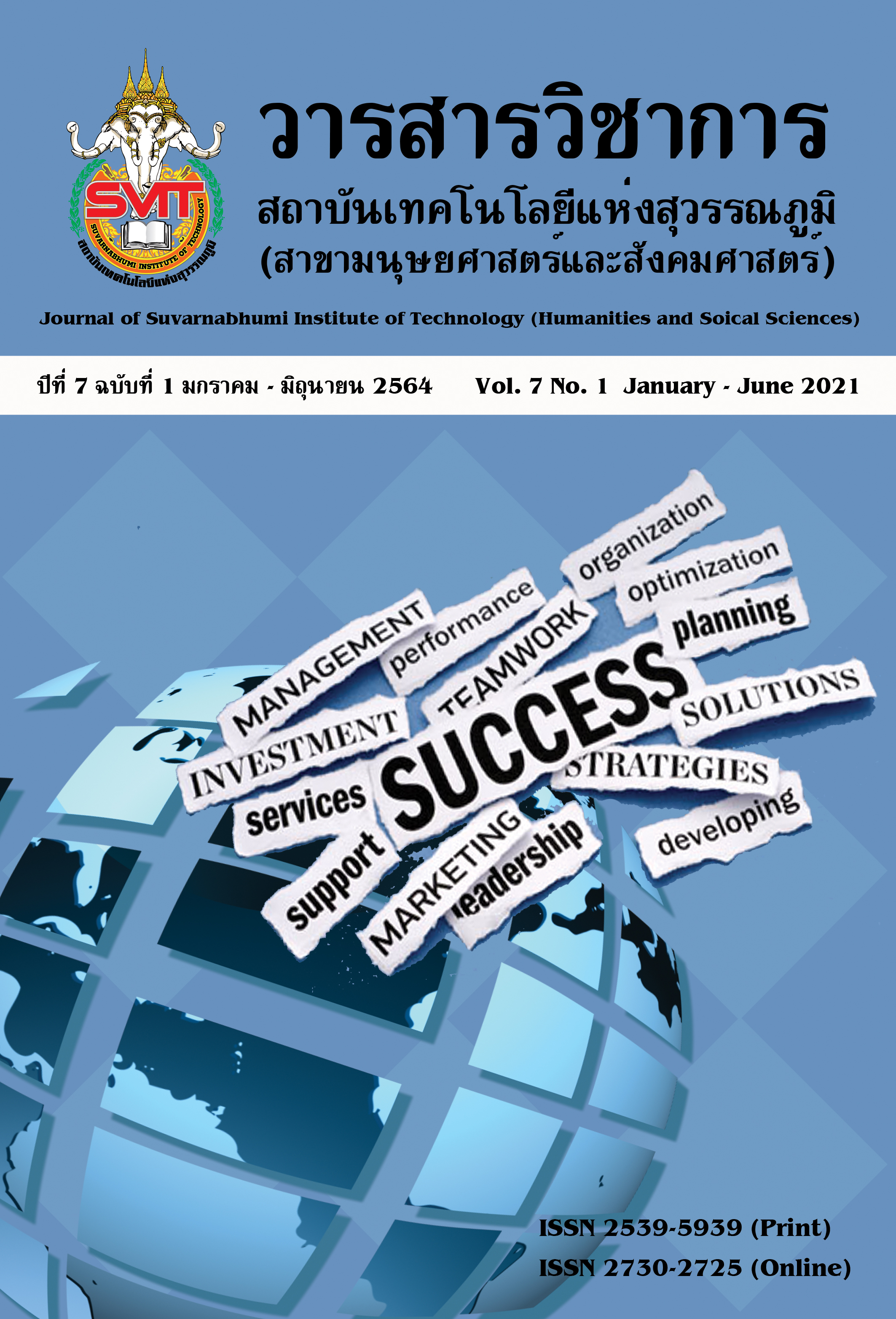กลยุทธ์การฟื้นฟูบริการที่ส่งผลต่อความจงรักภักดีในตราสินค้าของลูกค้าบัตรเครดิต
คำสำคัญ:
กลยุทธ์การฟื้นฟูบริการ, ความจงรักภักดี, บัตรเครดิตบทคัดย่อ
งานวิจัยนี้มีวัตถุประสงค์เพื่อ ศึกษาถึงกลยุทธ์การฟื้นฟูบริการของแต่ละปัญหาการร้องเรียนที่ส่งผลต่อความจงรักภักดีของลูกค้าธุรกิจบัตรเครดิตในประเทศไทย ด้วยวิธีการวิจัยเชิงปริมาณ โดยเก็บแบบสอบถามจากกลุ่มตัวอย่างจากลูกค้าที่ถือครองบัตรเครดิตทั้งหมดในประเทศไทยแล้วเกิดรายการที่เป็นข้อขัดข้องเกิดขึ้นในการใช้บัตรเครดิตชำระสินค้าและบริการ และร้องเรียนแจ้งเหตุการณ์กลับมายังผู้ออกบัตรจำนวน 407 ราย วิเคราะห์ข้อมูลจาก ค่าร้อยละ ค่าเฉลี่ย ค่าส่วนเบี่ยงเบนมาตรฐาน และวิเคราะห์ความถดถอยเชิงพหุ ที่ระดับนัยสำคัญทางสถิติ .05 ผลการวิจัยพบว่า กลยุทธ์การให้ชดเชยในเหตุการณ์เกิดรายการที่ไม่ได้ทำรายการ เหตุการณ์สั่งซื้อสินค้าบริการแต่ไม่ได้รับ เกิดรายการเรียกเก็บซ้ำ และเหตุการณ์สินค้าไม่เป็นไปตามที่ตกลง มีผลต่อความจงรักภักดีในตราสินค้าของลูกค้าบัตรเครดิตด้านการบอกต่อ โดยมีอิทธิพลเท่ากับ 0.33, 0.32, 0.31 และ 0.22 ตามลำดับ นอกจากนี้กลยุทธ์การฟื้นฟูบริการด้านการให้ชดเชยเมื่อเกิดรายการเรียกเก็บซ้ำมีผลต่อความจงรักภักดีในตราสินค้าของลูกค้าบัตรเครดิตด้านการใช้ซ้ำ โดยมีอิทธิพลเท่ากับ 0.31 ส่วนกลยุทธ์การกล่าวขอโทษเมื่อเกิดเหตุการณ์สั่งซื้อสินค้าบริการแต่ไม่ได้รับมีผลต่อความจงรักภักดีในตราสินค้าของลูกค้าบัตรเครดิตด้านการบอกต่อ โดยมีอิทธิพล เท่ากับ 0.35
เอกสารอ้างอิง
ธนาคารแห่งประเทศไทย. (2561). จำนวนบัตรพลาสติก . สืบค้นเมื่อ 15 ตุลาคม 2561, จาก www.bot.or.th
Archchana, Y. (2007). Impact of Service Recovery on Customer Loyalty: With Special Reference to People’s Bank 6th International Conference on Business & Information ICBI – 2015. Sri Lanka: Faculty of Commerce and Management Studies, University of Kelaniya.
Bell, C.R., & K. Ridge. (1992). Service recovery for trainers. Training & Development, 46(5), 58-63.
Blodgett, Jeffrey G., et al.(1997). The effects of distributive, procedural, and interactional justice on postcomplaint behavior. Journal of Retailing, 73(2), 185-210.
Cengiz, Ekrem, Bünyamin, E. and Kurtaran, A. (2007). The effects of failure recovery strategies on customer behaviours via complainants' perceptions of justice dimensions in banks.
ResearchGate, 2, 173-196.
Davidow, M. (2003). Organizational responses to customer complaints: What works and what
doesn’t. Journal of Service Research, 5(3), 225-250.
Dispute Resolution Cycle. (2018). Responding to a dispute. Retrieved form https://www.visa.co.th/
Fornell, C. (1992). A National Customer Satisfaction Barometer: The Swedish Experience. Journal of Marketing, 56, 6-21.
Hoffman, K.D., S.W. Kelley., & H.M. Rotalsky. (1995). Tracking service failures and employee recovery efforts. Journal of Services Marketing, 9(2), 49-61.
J.L. Miller., et al. (2000). The need for service recovery. Service recovery involves those actions designed. Journal of Operations Management, 18(2), 387-400.
Kau and Elizabeth. (2006). The effects of service recovery on consumer satisfaction: a comparison between complainants and non-complainants. Journal of Services Marketing, 20(2), 101-111.
Lewis, B. R., & Spyrakopoulos, S. (2001). Service Failures and Recovery in Retail Banking: The Customer Perspective. International Journal of Bank Marketing, 19(1), 37-47.
Makau, Lorna K. (2013). Customer service recovery processes: A case study of Kenya Commercial Bank (KCB) Group. (A Management Research Project Submitted in Partial Fulfilment of the Requirements for the Award of the Degree of Master of Business Administration (MBA)), School of Business, University of Nairobi.
Maxham, J. G. I., & R. G. Netemeyer. (2002). Modeling customer perceptions of complaint handling over time: The effects of perceived justice on satisfaction and intent. Journal of Retailing, 78(4), 239-252.
Michel, S. (2001). Analyzing service failures and recoveries: A process approach. International Journal of Service Industry Management, 12(1), 20-33.
Morrisson, O. and Huppertz, J.W. (2010). External Equity, Loyalty Programme Membership, and Service Recovery. Journal of Services Marketing, 24, 244-254.
Olivier Morrisson., & John W. Huppertz. (2010). External equity, loyalty program membership, and service recovery. Journal of Services Marketing, 24(3), 244-254.
Seul Lee., & Brenda J. Cude. (2012). Consumer complaint channel choice in online and offline purchases. International Journal of Consumer Studies, 1, 90-96.
Shapiro and Gonders. (2006). Effect of communication mode in justice-based service recovery. Journal of Service Theory and Practice, 16(2), 124-144.
Singh, J., & E.I. Widing Robert. (1991). What occurs once consumers complain? A theoretical model for understanding satisfaction/dissatisfaction outcomes of complaint responses. European Journal of Marketing, 25(5), 30-46.
Smith, A.K., & R.N. Bolton. (1999). An experimental investigation of customer reactions to service failure and recovery encounters: Paradox of peril. Journal of Services Research, 1(1), 65-81.
Shapiro and Gonders. (2006). Effect of communication mode in justice-based service recovery. Journal of Service Theory and Practice, 16(2), 124-144.
Swanson, S.R. and Kelley, S.W. (2001). Service recovery attributions and word-of-mouth intentions. European Journal of Marketing, 35(1/2), 194-211.
ดาวน์โหลด
เผยแพร่แล้ว
ฉบับ
ประเภทบทความ
สัญญาอนุญาต
บทความที่ได้รับการตีพิมพ์เป็นลิขสิทธิ์ของวารสารวิชาการ สถาบันเทคโนโลยีแห่งสุวรรณภูมิ
ข้อความที่ปรากฏในบทความแต่ละเรื่องในวารสารวิชาการเล่มนี้เป็นความคิดเห็นส่วนตัวของผู้เขียนแต่ละท่านไม่เกี่ยวข้องกับสถาบันเทคโนโลยีแห่งสุวรรณภูมิ และคณาจารย์ท่านอื่นๆในสถาบันฯ แต่อย่างใด ความรับผิดชอบองค์ประกอบทั้งหมดของบทความแต่ละเรื่องเป็นของผู้เขียนแต่ละท่าน หากมีความผิดพลาดใดๆ ผู้เขียนแต่ละท่านจะรับผิดชอบบทความของตนเองแต่ผู้เดียว





